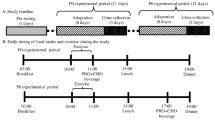Summary
The effects were investigated in ten women of intensive heavy resistance strength training lasting for 3 weeks on electromyographic (EMG) activity, muscle cross-sectional area (CSA) and voluntary force production characteristics of leg extensor muscles. Blood samples for the determinations of serum hormones were taken from five of the subjects. Significant increases occurred in the higher force portions of the isometric force-time curve with an increase of 9.7 (SD 8.4)% (P<0.01) in maximal peak force. An increase of 15.8 (SD 20.9)% (P<0.05) took place also in the maximal neural activation (integrated EMG) of the trained muscles, while an enlargement of 4.6 (SD 7.4)% (P<0.05) occurred in the CSA of the quadriceps femoris muscle. Maximal force per muscle CSA increased significantly (P<0.05). No statistically significant changes were observed during the training in the mean concentrations of serum testosterone, free testosterone, cortisol and sex hormone binding globulin (SHBG). The individual concentrations of serum testosterone: SHBG ratio correlated with the individual changes obtained during the training in the muscle CSA (r=0.99;P<0.01). The present findings in women indicated that the increases in maximal strength during short-term but intensive strength training were primarily due to the increased voluntary activation of the trained muscles, while muscle hypertrophy remained limited in magnitude. Large interindividual differences in women in serum testosterone concentrations could indicate corresponding differences in muscle hypertrophy and strength development even during a short-term but intensive strength training period.
Similar content being viewed by others
References
Cureton K, Collins M, Hill D, Mcelhannon F (1988) Muscle hypertrophy in men and women. Med Sci Sports Exerc 19: 338–344
Durnin J, Rahaman M (1967) The assessment of the amount of fat in the human body from measurements of skinfold thickness. Br J Nutr 21: 681–689
Häkkinen K (1989a) Muscle cross-sectional area, force production and relaxation characteristics in male and female strength athletes. In: Högfors C (ed) Proceedings of the Third International Biomechanics Seminar. Centre for Biomechanics, Chalmers University of Technology and Göteborg University. pp 144–161
Häkkinen K (1989b) Neuromuscular and hormonal adaptations during strength and power training. A review. J Sports Med 29: 9–26
Häkkinen K, Komi PV (1983) Electromyographic changes during strength training and detraining. Med Sci Sports Exerc 15: 455–460
Häkkinen K, Alén M, Komi PV (1985a) Changes in isometric force- and relaxation-time, electromyographic and muscle fiber characteristics of human skeletal muscle during strength training and detraining. Acta Physiol Scand 125: 573–585
Häkkinen K, Pakarinen A, Alén M, Komi PV (1985b) Serum hormones during prolonged training of neuromuscular performance. Eur J Appl Physiol 53: 287–293
Häkkinen K, Pakarinen A, Alén M, Kauhanen H, Komi PV (1987) Relationships between training volume, physical performance capacity and serum hormone concentrations during prolonged training in elite weightlifters. Int J Sports Med [Suppl] 8: 61–65
Häkkinen K, Pakarinen A, Alén M, Kauhanen H, Komi PV (1988) Daily hormonal and neuromuscular responses to intensive strength training in one week. Int J Sports Med 9: 422–428
Häkkinen K, Pakarinen A, Komi PV, Ryushi T, Kauhanen H (1989) Neuromuscular adaptations and hormone balance in strength athletes, physically active males and females during intensive strength training. In: Gregor J, Zernicke R, Whiting W (eds) The Proceedings of the XII International Congress of Biomechanics, University of California, Los Angeles, USA, pp 8–9
Häkkinen K, Pakarinen A, Kyröläinen H, Cheng S, Kim DH, Komi PV (1990) Neuromuscular adaptations and serum hormones in females during prolonged power training. Int J Sports Med 11: 91–98
Häkkinen K, Kallinen M, Komi PV, Kauhanen H (1991) Neuromuscular adaptations during short-term “normal” and reduced training periods in strength athletes. Electromyogr Clin Neurophysiol 31: 35–42
Hetrick F, Wilmore J (1979) Androgen levels and muscle hypertrophy during an eight-week training program for men/women (abstract). Med Sci Sports 11: 102
Komi PV (1973) A new electromechanical ergometer. In: Hauser G, Mellerowicz H (eds) 3. Internationales Seminar für Ergometrie. Ergon, Berlin, pp 173–176
Komi PV (1986) Training of muscle strength and power: interaction of neuromotoric, hypertrophic, and mechanical factors. Int J Sports Med [Suppl] 7: 10–15
Krahenbuhl G, Archer P, Pettil L (1978) Serum testosterone and adult female trainability. J Sports Med 18: 359–364
Moritani T, DeVries H (1979) Neural factors versus hypertrophy in the time course of muscle strength gain. Am J Phys Med 58: 115–130
Ryushi T, Hakkinen K, Kauhanen H, Komi PV (1988) Muscle fiber characteristics, muscle cross-sectional area and force production in strength athletes, physically active males and females. Scand J Sports Sci 10: 7–15
Sale D (1988) Neural adaptation in strength training. Med Sci Sports Exerc 20 [Suppl] 5135–5145
Staron R, Malicky E, Leonardi M, Falkel J, Hagerman F, Dudley G (1989) Muscle hypertrophy and fast fiber type conversions in heavy resistance-trained women. Eur J Appl Physiol 60: 71–79
Stone M, O'Bryant H (1984) Weight training. A scientific approach. Ballwelher Press, Minneapolis, Minn.
Stone M, O'Bryant H, Garhammer J (1981) A hypothetical model for strength training. J Sports Med 21: 342–351
Viitasalo J, Saukkonen S, Komi PV (1980) Reproducibility of measurements of selected neuromuscular performance variables in man. Electromyogr Clin Neurophysiol 20: 487–501
Westerlind K, Byrnes W, Freedson P, Katch F (1987) Exercise and serum androgens in women. Phys Sportsmed 15: 87–94
Young RJ, Ismail A, Bradley A, Corrigan DL (1976) Effect of prolonged exercise on serum testosterone levels in adult men. Br J Sports Med 10: 230–235
Author information
Authors and Affiliations
Rights and permissions
About this article
Cite this article
Häkkinen, K., Pakarinen, A. & Kallinen, M. Neuromuscular adaptations and serum hormones in women during short-term intensive strength training. Europ. J. Appl. Physiol. 64, 106–111 (1992). https://doi.org/10.1007/BF00717946
Accepted:
Issue Date:
DOI: https://doi.org/10.1007/BF00717946




